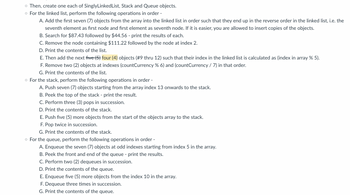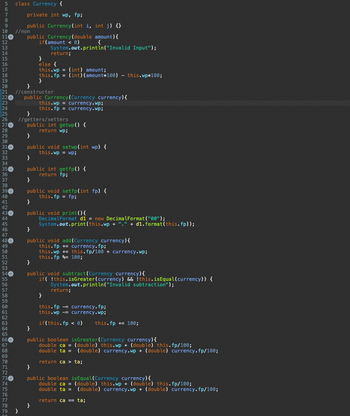
(In java please) ((please read instruction and look at the images please i keep getting wrong anwser no toy class)PLEASE i beg NO TOY CLASS PLEASE READ INSTRUCTION OR DOWN VOTE PLEASE LOOK AT TWO IMAGES BELOW FIRST ONE IS CURRENCY CLASS NEED THE SECOND IS INSTRUCTIONS ON HOW TO MAKE TEST CLASS. PLEASE NO TOY CLASS OR DOWN VOTE USE CURRENCY CLASS INSTEAD AND UPDATE IT) THIS A LinkNode structure or class which will have two attributes - a data attribute, and a pointer attribute to the next node. The data attribute of the LinkNode should be a reference/pointer of the Currency class of Lab 2. Do not make it an inner class or member structure to the SinglyLinkedList class of #2 below. A SinglyLinkedList class which will be composed of three attributes - a count attribute, a LinkNode pointer/reference attribute named as and pointing to the start of the list and a LinkNode pointer/reference attribute named as and pointing to the end of the list. Since this is a class, make sure all these attributes are private. The class and attribute names for the node and linked list are the words in bold in #1 and #2. For the Linked List, implement the following linked-list behaviors as explained in class - getters/setters/constructors/destructors, as needed, for the attributes of the class. createList method in addition to the constructor - this is optional for overloading purposes. destroyList method in place of or in addition to the destructor - this is optional for overloading purposes, addCurrency method which takes a Currency object and a node index value as parameters to add the Currency to the list at that index. removeCurrency method which takes a Currency object as parameter and removes that Currency object from the list and may return a copy of the Currency. removeCurrency overload method which takes a node index as parameter and removes the Currency object at that index and may return a copy of the Currency. findCurrency method which takes a Currency object as parameter and returns the node index at which the Currency is found in the list. getCurrency method which takes an index values as a parameter and returns the Currency object. printList method which returns a string of all the Currency objects in the list in the order of index, tab spaced. isListEmpty method which returns if a list is empty or not. countCurrency method which returns a count of Currency nodes in the list. Any other methods you think would be useful in your program. A Stack class derived from the SinglyLinkedList but with no additional attributes and the usual stack methods - constructor and createStack (optional) methods, push which takes a Currency object as parameter and adds it to the top of the stack. pop which takes no parameter and removes and returns the Currency object from the top of the stack. peek which takes no parameter and returns a copy of the Currency object at the top of the stack. printStack method which returns a string signifying the contents of the stack from the top to bottom, tab spaced. destructor and/or destroyStack (optional) methods. Ensure that the Stack objects do not allow Linked List functions to be used on them. A Queue class derived from the SinglyLinkedList but with no additional attributes and the usual queue methods - constructor and createQueue (optional) methods, enqueue which takes a Currency object as parameter and adds it to the end of the queue. dequeue which takes no parameter and removes and returns the Currency object from the front of the queue. peekFront which takes no parameter and returns a copy of the Currency object at the front of the queue. peekRear which takes no parameter and returns a copy of the Currency object at the end of the queue. printQueue method which returns a string signifying the contents of the queue from front to end, tab spaced. destructor and/or destroyQueue (optional) methods. Ensure that the Queue objects do not allow Linked List functions to be used on them. Ensure that all your classes are mimimal and cohesive with adequate walls around them. Make sure to reuse and not duplicate any code. Then a main driver program that will demonstrate all the capabilities of your ADTs as follows - First, print a Welcome message for the demonstration of your ADTs - you can decide what the message says but it should include your full name(s). Second, create the following twenty (20) Dollar objects in a Currency array to be used in the program. $57.12 $23.44 $87.43 $68.99 $111.22 $44.55 $77.77 $18.36 $543.21 $20.21 $345.67 $36.18 $48.48 $101.00 $11.00 $21.00 $51.00 $1.00 $251.00 $151.00


Step by stepSolved in 4 steps

- 13) What's a Map? Homework • Unanswered Select all true statements from the below. Multiple answers: Multiple answers are accepted for this question Select one or more answers and submit. For keyboard navigation. SHOW MORE v a The idea of a map is to be able to look up one value with another. Often the lookup value is called the key and the looked-up value is called simply the value. As such, we see that any data structure essentially performs the actions required of a map.arrow_forwardClasses, Objects, Pointers and Dynamic Memory Program Description: This assignment you will need to create your own string class. For the name of the class, use your initials from your name. The MYString objects will hold a cstring and allow it to be used and changed. We will be changing this class over the next couple programs, to be adding more features to it (and correcting some problems that the program has in this simple version). Your MYString class needs to be written using the .h and .cpp format. Inside the class we will have the following data members: Member Data Description char * str pointer to dynamic memory for storing the string int cap size of the memory that is available to be used(start with 20 char's and then double it whenever this is not enough) int end index of the end of the string (the '\0' char) The class will store the string in dynamic memory that is pointed to with the pointer. When you first create an MYString object you should…arrow_forwardUsing C++, create statements that do the following: Define an enum type, birdType, with the values PEACOCK, SPARROW, CANARY, PARROT, PENGUIN, OSTRICH, EAGLE, CARDINAL, and HUMMINGBIRD. Declare a variable bird of the type birdType. Assign CANARY to the variable bird. Advance bird to the next value in the list. Decrement bird to the previous value in the list. Output the value of the variable bird. Input value in the variable bird.arrow_forward
- (In Java language) Create a class Called NetflixDemo Create two objects “user1” and “user2” of the Netflix class pictured below) Set various class variables for the Netflix class using these two objects. Call various methods of Netflix class using these two objects. public class Netflix {public String movies [] = new String[10];public String trendingTop5 [] = new String[5];public String continueWatching [] = new String[5];public String username;public String password;private boolean isAuthenticated;public double balance;public int subscriberSinceYear;public static void logininfo() {Scanner input = new Scanner(System.in);System.out.println("Enter the username");String username = input.nextLine();System.out.println("Enter the password");String password = input.nextLine();boolean isAuthenticated = true;System.out.println(isAuthenticated + " , You have successfully logged in ");System.out.println();}public static void trendingList(){Scanner input = new…arrow_forward(Java) Open up Eclipse and create a new class called ArrayListPractice.java Next, copy and paste the below program into your file and run the code. Your job is to take the given code, remove all the arrays and replace them with the identical ArrayLists. There should be no arrays in your program. You will need to call the ArrayList methods as defined in the lesson notes above. Note that you will not be able to do method overloading with ArrayLists so you should assign different names to your methods. Once you have made the changes, you should get identical output as the given version of the program. Submit your program when you are finished. /** * @author * CIS 36B * Activity 5.2 */ import java.util.ArrayList; import java.util.Scanner; public class ArrayListPractice { public static void main(String[] args) { int scores[] = {95, 96, 97, 98, 99}; System.out.println("Integer test scores:"); print(scores); System.out.println();…arrow_forwardGive an example of a function with two arguments and statements that are executed when the function is called. -Provide details about the return statement and the purpose of your function. -Provide an example of an array and a vector. -Describe your experience using GitHub, GitLab, Git, or other versional control software in general. Explain what aspects of the GitHub process you are comfortable with and what areas you need more practice or help.arrow_forward
 Computer Networking: A Top-Down Approach (7th Edi...Computer EngineeringISBN:9780133594140Author:James Kurose, Keith RossPublisher:PEARSON
Computer Networking: A Top-Down Approach (7th Edi...Computer EngineeringISBN:9780133594140Author:James Kurose, Keith RossPublisher:PEARSON Computer Organization and Design MIPS Edition, Fi...Computer EngineeringISBN:9780124077263Author:David A. Patterson, John L. HennessyPublisher:Elsevier Science
Computer Organization and Design MIPS Edition, Fi...Computer EngineeringISBN:9780124077263Author:David A. Patterson, John L. HennessyPublisher:Elsevier Science Network+ Guide to Networks (MindTap Course List)Computer EngineeringISBN:9781337569330Author:Jill West, Tamara Dean, Jean AndrewsPublisher:Cengage Learning
Network+ Guide to Networks (MindTap Course List)Computer EngineeringISBN:9781337569330Author:Jill West, Tamara Dean, Jean AndrewsPublisher:Cengage Learning Concepts of Database ManagementComputer EngineeringISBN:9781337093422Author:Joy L. Starks, Philip J. Pratt, Mary Z. LastPublisher:Cengage Learning
Concepts of Database ManagementComputer EngineeringISBN:9781337093422Author:Joy L. Starks, Philip J. Pratt, Mary Z. LastPublisher:Cengage Learning Prelude to ProgrammingComputer EngineeringISBN:9780133750423Author:VENIT, StewartPublisher:Pearson Education
Prelude to ProgrammingComputer EngineeringISBN:9780133750423Author:VENIT, StewartPublisher:Pearson Education Sc Business Data Communications and Networking, T...Computer EngineeringISBN:9781119368830Author:FITZGERALDPublisher:WILEY
Sc Business Data Communications and Networking, T...Computer EngineeringISBN:9781119368830Author:FITZGERALDPublisher:WILEY





